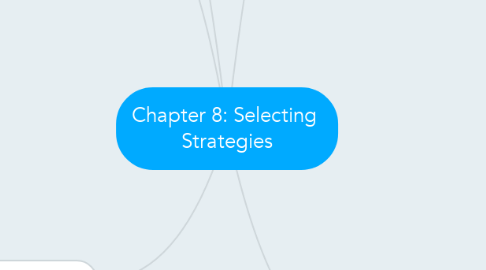
1. Selecting Strategies - priority number one is selecting strategies that support the identified learning outcomes
2. Nine categories of effective strategies
2.1. Identify similarities and differences
2.2. Summarize and take notes
2.3. Reinforce effort and provide recognition
2.4. Homework and practice
2.5. Non-linguistic representation
2.6. Cooperative learning
2.7. Set objectives and provide feedback
2.8. Generate and test hypotheses
2.9. Cues, questions, and advance organizers
3. Instructional Frameworks
3.1. ADDIE
3.2. Gagne’s Nine Events of Instruction
3.2.1. Gaining attention
3.2.2. Informing the learner of the objective
3.2.3. Stimulating recall of prerequisite learning
3.2.4. Presenting instruction
3.2.5. Providing learning guidance
3.2.6. Eliciting performance
3.2.7. Providing feedback
3.2.8. Assessing performance
3.2.9. Enhancing retention and transfer
3.3. BSCS Five Es Instructional Model
3.3.1. Engagement
3.3.2. Exploration
3.3.3. Explanation
3.3.4. Elaboration
3.3.5. Evaluation
3.3.6. Refer to Table 8.9 for full descriptions
3.4. Connectivist Learning Environment Planning Framework
3.4.1. Refer to Table 8.10
3.5. Keller’s ARCS Motivational Model
3.5.1. Gain and maintain the learner’s ATTENTION
3.5.2. Provide RELEVANCE to make the connection between the instruction and the learner’s personal learning goals explicit
3.5.3. Encourage the right amount of CONFIDENCE in the learner so that they make sufficient effort to learn the material
3.5.4. SATISFY the learner that their needs will be met by completing the instruction
4. Scaffolding
4.1. Instructional support that facilitates learning
4.2. Scaffolding strategies are categorized as either supplantive or generative
4.2.1. Supplantive strategies are those that supplant or do more of the mental processing for the learner by explicitly stating instructional goals and providing information on how to think about, structure, and retain the content.
4.2.2. Generative strategies are those that encourage or allow learners to define their own learning goals, organize the material in whatever manner works best for them, control the sequencing and pace of the instruction, self-monitor their own understanding, and transfer the knowledge to new contexts.
4.2.3. Refer to Table 8.6 for a decision chart providing guidance on whether or not to use higher or lower levels of scaffolding
4.3. Job aids - a type of scaffolding that work as quick reference aids and are typically cheaper to develop and focus on supporting and improving performance. Typically used when reliance on memory is not essential, using the aid would allow a task to be performed more efficiently, there are a substantial number of steps in the task, the task is performed infrequently, and/or the task is complex.
5. Five Steps to identify instructional strategies
5.1. Revisit and refine the learning context design
5.1.1. Both instructional and practical project factors interact to influence the design which makes it a good idea to obtain early approval of your plans for the learning context.
5.2. Identify assumptions and pedagogical approaches
5.2.1. Structural elements define what is possible in terms of strategies. Reflect on assumptions that lead to pedagogical approaches that are supported by interactions and accomplished through instructional strategies.
5.2.2. Refer to guidelines in Table 8.3
5.3. Identify appropriate interactions and strategies
5.3.1. All instruction involves on or more types of interaction.
5.3.2. Interaction can be a goal in itself or it can be used to accomplish other learning outcomes
5.3.3. Instructional interactions are fostered through organizational strategies.
5.3.4. Five types of interaction used for face to face, blended, and/or fully online environments
5.3.4.1. Learner-to-Content Interaction: How learners interact with the content
5.3.4.2. Learner-to-Instructor Interaction: Interaction with an instructor that must be planned for online environments.
5.3.4.3. Learner-to-Context Interaction: Learners react to the learning context and therefore a designer should take into consideration ways to improve learning through context design.
5.3.4.4. Learner-to-learner Interaction: Learners interacting with each other in virtual and physical learning environments to discuss content and ideas, seek and respond to others’ comments, conduct experiments, collaborate to solve problems, construct meaning, construct projects and other artifacts, share content they’ve discovered or created, build team and communication skills, and more.
5.3.4.5. Learner-to-self Interaction: Reflection on the learning process for developing self-directed learners. Metacognitive type of interaction.

